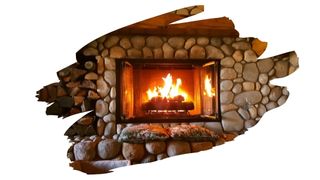The best type of wood for a fireplace is always going to be natural solid wood. Free of any chemical or poisonous compounds, air-dried seasoned wood isn’t going to fill your home with noxious fumes.
But, what about kiln dried wood?
This specially heat-treated wood does not involve saturating wood with wood preservatives or other fungicides. Yet, does that mean you can always safely burn kiln-dried wood for fuel?
Well, keep reading, because in this post we dive into what you should check for in clean burning firewood. You will also learn how kiln-dried wood differs from air-dried seasoned timber — and whether or not kiln drying makes for better firewood.

This post may contain affiliate links to products that we receive a commission for (at no additional cost to you). Learn more here.
What Is The Safest Type Of Wood You Can Use In a Fireplace?
The safest type of wood doesn’t produce much smoke, doesn’t contain toxins, and does not contain a lot of sap. And, you want dry dense clean burning firewood that can burn hot for a good long while.
This is why hardwoods such as White Oak and Birch wood are two great affordable firewood options.
And What Kind Of Wood Should Never Be Burn In A Fireplace?
Always avoid wood types that can release toxic fumes or otherwise back-up chimneys.
So, wood types that come from trees that contain toxic compounds, should never find their way into your fireplace. On top of that, wood that’s been soaked in chemicals (pressure treated) or contains adhesives (plywood) should be avoided too.
And be on the lookout for sap-saturated timbers, such as Cedar or Pine. These particular types of wood have a lot of tree resin in them — which makes them fire hazards waiting to happen.
Why? Well, because all of that sticky tree resin can cause chimney flues to become backed up. And that, in turn, can lead to chimney fires.
OK. What About Kiln Dried Wood? Is It Safe Enough To Use As Firewood?
Kiln dried timber is simply wood that has been dried and seasoned in a kiln oven. Thanks to this super-heated treatment, kiln-dried wood dries in a fraction of the time of traditionally seasoned wood.
Related Post: How To Season Wood (7 Tips)
So, at the end of the day, there’s nothing inherently dangerous about natural solid wood that has been kiln-dried.
This is because kiln-drying does not require additional chemical treatments. Instead, kiln dried wood is left to slowly dry for nearly 36 hours at roughly 94°C (201.2°F).
But, because kiln dried wood is heat-treated as opposed to air-dried, it has a much lower moisture content than regular seasoned lumber.
Traditionally air-dried seasoned wood can take six to twelve months for it’s moisture content to fall below nineteen percent. But, kiln dried woods moisture content can drop to as low as twelve percent in mere days.
Come Again…What Do You Mean By Moisture Content?
Moisture content is simply a quickly way to measure the amount of water there is inside a piece of wood.
Newly logged lumber (also referred to as ‘green wood’) has a lot of water in it. And the moisture content of freshly cut green wood is around one hundred percent.
Related Post: Can You Paint Green Wood? (Solved!)
Got It… So Is Kiln Dried Wood Safe Enough To Put In My Fireplace?
If it’s only been kiln-dried, then you can go ahead and throw that log onto the fire. This is, of course, all dependent on firewood having come from a clean burning wood species in the first place.
Related Post: Can You Safely Burn Camphor Wood In A Fireplace?
But, here’s the rub…unless you’ve kiln-dried that firewood yourself, you can’t always be certain that it hasn’t been further treated with chemicals.
That’s because kiln-dried timber often gets placed through an additional milling process known as ‘pressure treatment’. Pressure treating wood involves saturating wood with water-soluble chemical preservatives.
This particular type of kiln-dried lumber will often have been stamped ‘KDAT’, which stands for K.iln D.ried A.fter T.reating. And because of the chemicals saturating KDAT wood, it should never be burned in your fireplace.
But How Can You Know If Kiln Dried Wood Has Been Pressure Treated?
Simply check for the KDAT stamp. Or, in the case of Kiln-Dried Pallet wood, you can check if they’ve been stamped with GC (Ground Contact) or PT (Pressure Treated).
Any kiln dried wood with these stamps has been soaked in chemical antibacterial preservatives. And so they should not go in your fireplace.
But, if you’re sure that wood has not been chemically treated, then go right ahead and burn that log.
Do Kiln Dried Logs Burn Too Quickly? Well, because of their extra low moisture content, kiln dried wood will burn up a fair bit faster than air-dried seasoned wood. But it’s the density of wood that has the biggest impact on how long a wooden log will burn for.
To Wrap Up, Here Are The 3 Key Takeaways From This Post…
- 1). Kiln drying wood is a fast-track method for seasoning wood. By placing wood in a kiln oven, you can dry out wood in a matter of days (rather than over a number of months).
- 2). Untreated kiln dried timber is perfectly safe to burn in your fireplace. Kiln drying wood does not involve any chemical treatments, so there are no toxins saturating that wood grain.
- 3). But, KDAT wood is a different story. KDAT wood has been kiln dried after having been treated with chemical wood preservatives. This particular type of kiln dried wood is not safe to burn in your fireplace.
References:
Wood Smoke Awareness | EPA.gov



